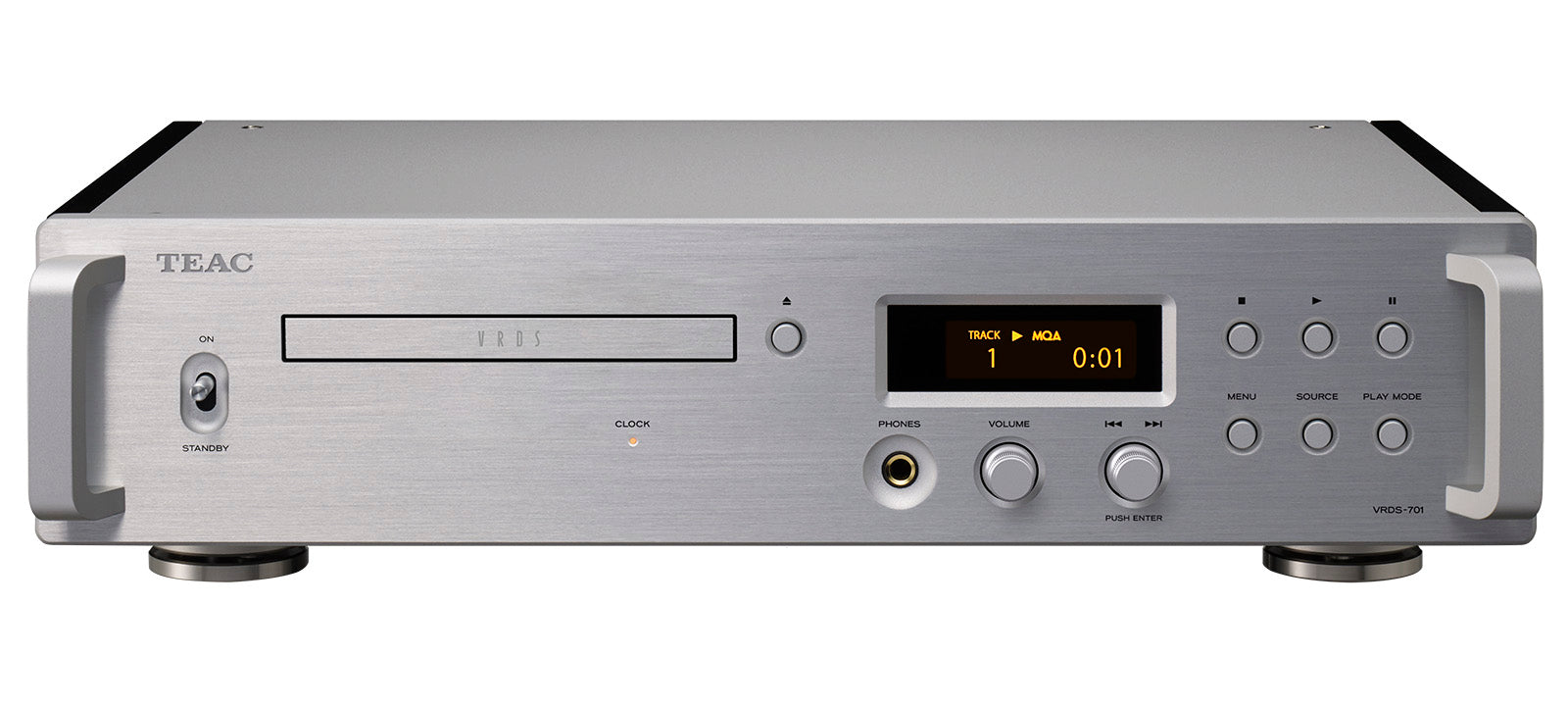Teac VRDS-701 CD Player
- A newly developed VRDS mechanism is used for the CD drive
- An original TEAC-designed discrete DAC is used for the digital audio converter, which is key to determining audio quality
- Fully-balanced dual mono circuit structure realizes outstanding channel separation
- Direct connection with a power amplifier is possible thanks to volume control that uses a TEAC-QVCS analog preamp circuit
- Along with MQA CD playback, full MQA decoding of digital input is possible
- As a USB DAC, 22.5MHz DSD and 384kHz/32-bit PCM data can be played back
- 2×, 4× and 8× upconversion using RDOT-NEO
- 10MHz external clock input
- Analog, digital input/output and CD drive circuits each have dedicated Toroidal core transformers
- Original TEAC-HCLD2 enhanced-current output buffer circuit
- Headphone amp has a high output circuit with low distortion, high signal-to-noise ratio and a high 2000V/μs through rate
- Overall dimensions 444 (W) × 111 (H) × 333 (D) mm (including protrusions)
- Weight 11.1kg
Commemorating the 70th anniversary of our founding, this model brings innovation and epitomizes TEAC strengths, including a newly-developed VRDS mechanism.
The VRDS-701 CD player employs a newly-developed VRDS mechanism and a TEAC original discrete DAC.
The VRDS is a TEAC-original CD drive mechanism that reduces rotation vibration and other unwanted vibration by clamping the CD to an aluminum turntable with the same diameter in order to maximize inertial mass.
Furthermore, instead of an ordinary DAC IC for the DAC section, which is crucial to audio quality,
the VRDS-701 has a TEAC ΔΣ (delta-sigma) discrete DAC that incorporates our unique algorithms in a discrete circuit.
Unconstrained by conventional CD player definitions, the VRDS-701 is enhanced with future-forward functionality.
The ability to play MQA CDs using full MQA decoding capabilities and support for 22.5MHz DSD and
384kHz/32-bit PCM formats as a USB DAC are some of the features that make it more than just a CD player.
Newly-developed VRDS mechanism Starting with a drive we developed that has a long record of use in professional applications, we added VRDS technologies, which are part of our TEAC legacy.
Vibration-Free Rigid Disc-Clamping System (VRDS) This TEAC-original CD drive mechanism reduces rotation vibration of the disc itself as well as unwanted mechanism vibration by clamping the CD to an aluminum turntable with the same diameter and maximizing inertial mass in order to stabilize rotation. Servo current is reduced with the turntable by Correcting disc warping and distortion and improving the relative optical axis Precision of the pickup and disc pit side. This realizes reduced disc reading errors and outstanding audio quality.
Bridge section supports the VRDS For the bridge that supports the turntable, we carefully selected lightweight materials that are very rigid and do not transmit vibration. By naturally settling vibrations quickly, we have realized a wide, dynamic sound. The bridge, which has a torus structure made of resin, is only fixed on one side, and propagation of vibration from the CD mechanism to the opposite side through the bridge is suppressed, so the entire mechanism minimizes unwanted sympathetic vibrations.
Semi-floating mounting The entire CD mechanism is mounted on the sub-chassis in a semi-floating state. By controlling the transmission of vibrations between the CD mechanism and the chassis, the impact of sympathetic vibrations is abated, and natural playback sound is realized throughout the frequency range. By isolating motor vibrations from the main chassis, sympathetic vibrations within the chassis are prevented. At the same time, the CD mechanism is also isolated from external vibrations. Reading Precision is also increased by isolating the CD mechanism from external vibrations.
TEAC ɅƩdelta-sigma discrete DAC Instead of an ordinary DAC IC, the DAC section, which is critical for determining the sound, is a TEAC ΔΣ (Delta Sigma) discrete DAC that consists of a discrete circuit structure that incorporates our unique algorithms using FPGA. DSD signals are left as is, while PCM signals are converted to either 1-bit or multi-bit signals, according to the end users choosing, using a ΔΣ modulator and then output as high-quality analog signals. The sound field that is wide and perfectly clear can be realized only because of this discrete design. The result is that we can say we have achieved the sound sought by TEAC. With a TEAC ΔΣ discrete DAC, playback of 22.5MHz DSD and 384kHz/32-bit PCM data is possible.
Dual mono structure Using independent left and right Toroidal core transformers, we have employed an indulgent dual mono structure for the circuitry from the power supply circuit through the D/A Converter section to the analog output stage.
The dual mono structure has two sets of circuitry that provide complete mono paths for each channel. This prevents interference between the left and right signals and realizes rich musical expression that emphasizes perception of the sound space and three dimensionality.
Fully balanced transmission at every stage Fully-balanced transmission of the left and right analog output signals from D/A conversion to the final output stage contributes greatly to improving the signal-to-noise ratio and extending the dynamic range. The sense of air that high-resolution audio sources have can be transmitted without loss in an even purer state.





